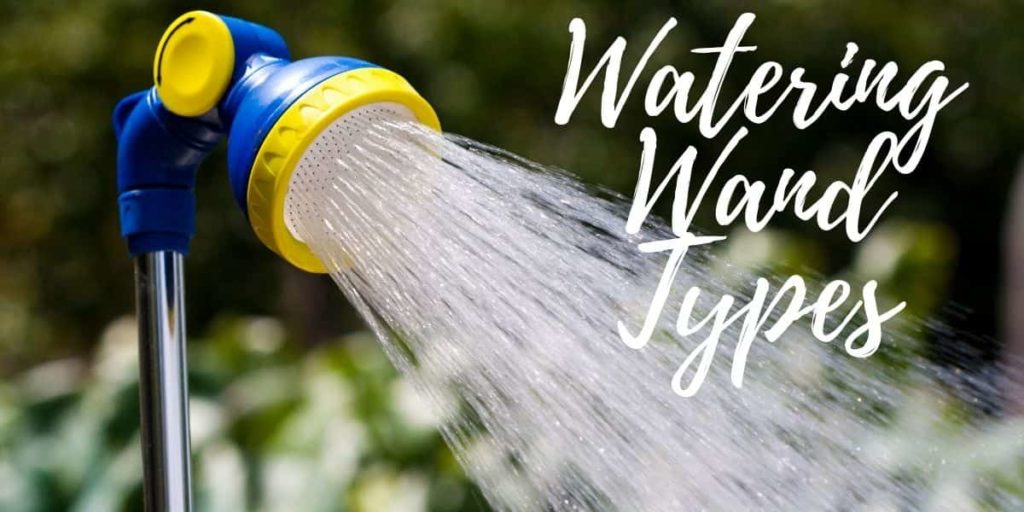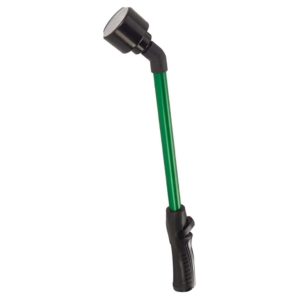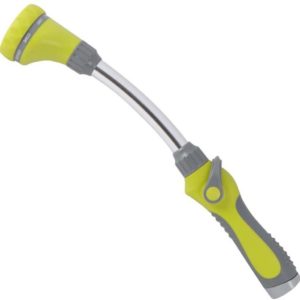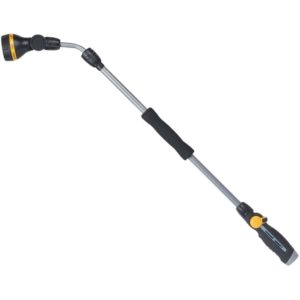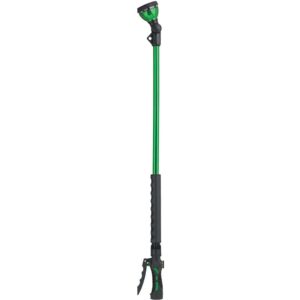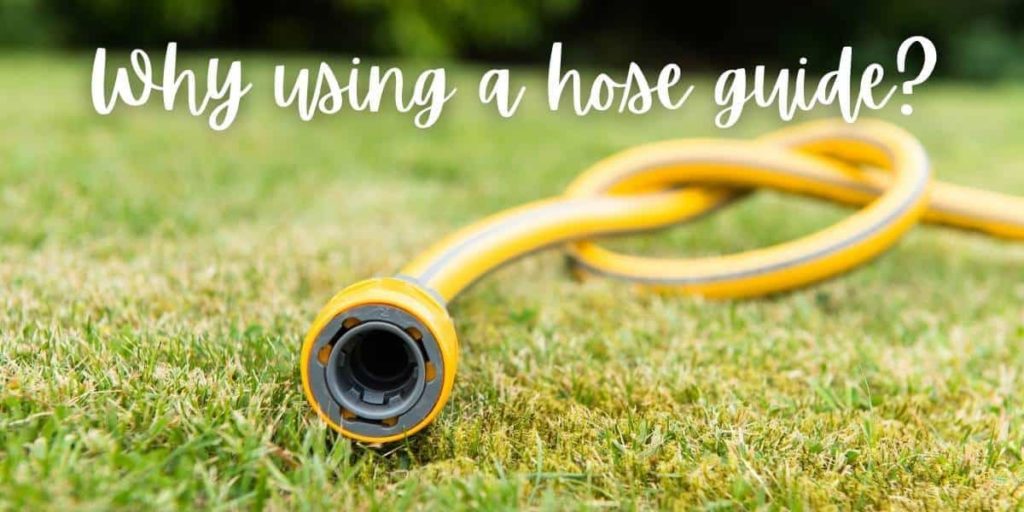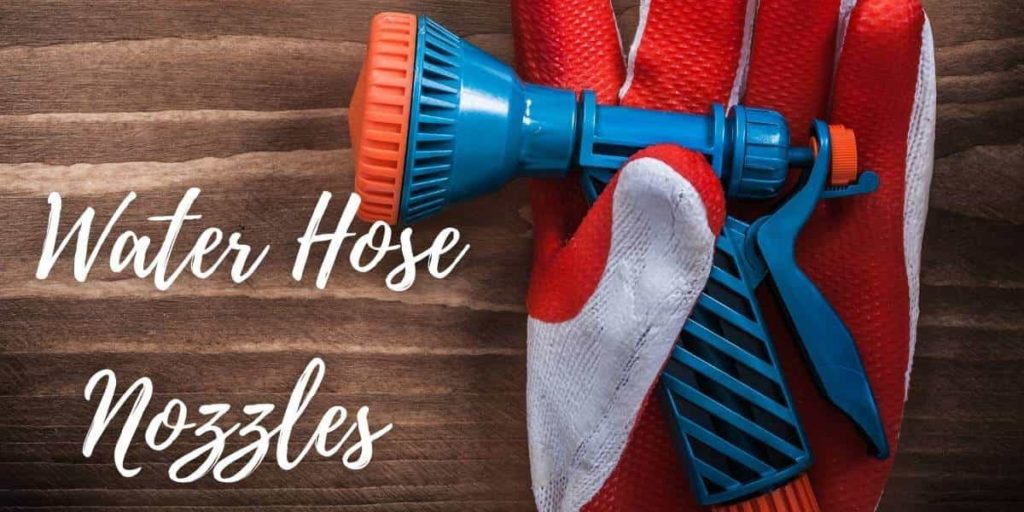Do you love growing flowers? We do! Therefore, we have a lot of hanging baskets around our house. But after planting our favorite flowers and installing each hanging basket in the right place, we understood that watering them will become an issue.
To solve this problem, we started searching for the perfect tool to do this job with, and we found it. The solution to our situation was purchasing a watering wand hose nozzle. And we recommend this wand nozzle to all our friends. It is a game-changer when you want to water hard-to-reach plant pots, especially hanging baskets.
The truth is there are a lot of different situations where using watering wands can make a difference. So, you will not purchase it just for one type of job.
In this post, we will talk more about what is a watering wand, how to use it, and what are the benefits of using one.
We will also list specific situations where hose wands are very useful and provide more details on the different wand types that are available. By the end of the post, you will have all the necessary information to decide if you need this type of water nozzle for your gardening hose. Make sure you keep reading until the end!
What Is a Watering Wand for Garden Hose?
We use a lot of different terms when referring to hose wands. You may call them garden hose lance attachments, watering lances, water wands, rain wands, and other similar names. But they all refer to this same special hose nozzle attachment.
Watering wands are hose-end attachments with similar functionalities as a standard hose water nozzle.
A watering wand is a special hose-end watering attachment, made of four main components: the hose connector, the wand grip, the water valve, the lever, and the nozzle head.
The hose wand lever is a solid water pipe of different or adjustable lengths. The wand lever has an ergonomic grip with a hose connector on one end, and a specific water shut-off valve installed near the grip. The opposite end of the lever has an inbuilt water nozzle, with single or multiple water spraying patterns available.
The wand nozzle lever has either a fixed length or nozzle head position, or an adjustable length and angles for the wand nozzle head. When using a watering wand, you will be able to direct the stream to the specific spot where is needed.
Watering wands often have adjustable spraying patterns similar to a standard water hose nozzle.
A hose wand can be actioned by either a front or rear trigger, a shut-off valve, or a thumb control handle.
The standard water stream provided by the garden wand nozzle is a rain-like spray. Hose wand shower distributes water evenly, with low to medium pressure. This gentle spray will not harm fragile or younger plants and it won’t wash the soil away.
But there are also new hose lance types, which include multiple water spraying patterns in the wand nozzle head.
As there are so many options available on the market today, we will continue listing below the main hose lance attachment types and their specific and differentiating features.
Which Are the Main Watering Wand Types?
Nowadays, hose water wands are no longer those simple watering tools with a single stream spray, the gentle shower, rain-like spray.
Manufacturers have upgraded the watering wands and added adjustable features in terms of hose lance length, or the capability of the wand nozzle head to be switched to different angles.
Based on the water flow operating mode, hose lance attachments hose wands can be categorized into the below model types.
- Click control button –turns the hose lance nozzle on/off with a simple push of a button.
- Front control grip handle– press the handle of the water wand to release the water flow. When you stop pressing it, the nozzle will turn off.
- Rear control grip handle– similar to the above model, the difference is the grip handle is placed on the backside of the water wand grip. And you push the handle with the back of your palm.
- Thumb control grip – turn the hose wand nozzle on/off by moving a water valve forward or backward. This valve is usually placed on top of the wand grip. You can control the water flow level by using your thumb.
- Shut Off valve – turn the water flow on or off, by switching the shut-off valve placed on the water wand grip.
Based on the available watering patterns, the hose lances can have a single type of water stream or multiple stream patterns.
1. Single sprayer pattern watering wand
This is the basic type of rain wand which you can use only on gentle, rain-like shower mode.
There are no other watering patterns available.
It usually has a shut-off valve, which you can switch to modify the water pressure and control the water flow.
So, there is no need to go back to the garden hose faucet to make these types of adjustments.
2. Multiple watering patterns hose wand
These types of hose lance attachments have different watering patterns available on the nozzle head.
You can switch from jet spray to a gentle shower by spinning the nozzle head.
Many watering lances in this category can have up to 10 different water stream patterns.
Among the frequently used nozzle watering patterns are Jet, Angled, Full, Soaker, Mist, Flat, Cone and Shower stream patterns.
Based on the adjustable length, hose wands can have a fixed length, or they can have a telescopic water lever.
3. Fixed length water hose wand
The fixed-length refers to the length of the hose wand lever. The length of the lever can be different depending on the model and brand.
For this type of watering wand, the length can’t be extended or decreased. The length range can vary from 12-13 inches to around 40 inches.
4. Telescopic watering lance
This type of long-reach watering wand easily extends from a few inches to more than 40 inches, in some cases.
Depending on the task you need your hose lance for, you can either increase or decrease the wand lever length, as needed.
It is very helpful in situations where you need to reach different plants, or spots in your garden, from a fixed position, without moving.
Use this wand nozzle for watering hanging baskets and shrubs.
It is also very handy in reaching high surfaces, when cleaning your house siding, for example.
4. Watering wand with pivoting head
This type of feature on a garden watering wand will allow you to change the nozzle head position to cover different angles.
The adjustable hose wand nozzle will allow you to change the nozzle head direction vertically and horizontally, in most cases. In other cases, only one of these pivoting nozzle head options will be available.
Usually, a wand nozzle head can be built to swing up to 180 degrees horizontally and 120 degrees vertically.
5. Pressure Wand For Garden Hose
The high-pressure hose wand has a special nozzle that will turn the water flow from your standard garden hose into a high-pressure jet.
This type of hose wand is mostly used in different cleaning activities such as washing your car using a garden hose, cleaning the outdoor walkways and patios, or gutter cleaning.
Conclusion
Garden hose wands or watering lances are great hose-end extensions, and you can use them for a lot of reasons.
But in this post, our purpose was to provide a clear definition of what a watering wand is.
Also, we briefly listed and explained how many types of water wands for hoses are available currently and how is each type different from the others. In case you are now to purchase one, the information provided in this post will help you understand which wand nozzle model you will need.
